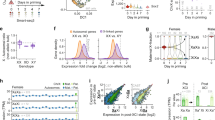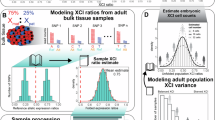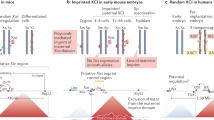Abstract
The phenomenon of X chromosome inactivation in female mammals is well characterised and remains the archetypal example of dosage compensation via monoallelic expression. The temporal series of events that culminates in inactive X-specific gene silencing by DNA methylation has revealed a ‘patchwork’ of gene inactivation along the chromosome, with approximately 15% of genes escaping. Such genes are therefore potentially subject to sex-specific imbalance between males and females. Aside from XIST, the non-coding RNA on the X chromosome destined to be inactivated, very little is known about the extent of loci that may be selectively silenced on the active X chromosome (Xa). Using longitudinal array-based DNA methylation profiling of two human tissues, we have identified specific and widespread active X-specific DNA methylation showing stability over time and across tissues of disparate origin. Our panel of X-chromosome loci subject to methylation on Xa reflects a potentially novel mechanism for controlling female-specific X inactivation and sex-specific dimorphisms in humans. Further work is needed to investigate these phenomena.
Similar content being viewed by others
Log in or create a free account to read this content
Gain free access to this article, as well as selected content from this journal and more on nature.com
or
References
Wutz A : Gene silencing in X-chromosome inactivation: advances in understanding facultative heterochromatin formation. Nat Rev Genet 2011; 12: 542–553.
Payer B, Lee JT, Namekawa SH : X-inactivation and X-reactivation: epigenetic hallmarks of mammalian reproduction and pluripotent stem cells. Hum Genet 2011; 130: 265–280.
Takagi N, Sasaki M : Preferential inactivation of the paternally derived X chromosome in the extraembryonic membranes of the mouse. Nature 1975; 256: 640–642.
Morey C, Avner P : The demoiselle of X-inactivation: 50 years old and as trendy and mesmerising as ever. PLoS Genet 2011; 7: e1002212.
Brown CJ, Lafreniere RG, Powers VE et al: Localization of the X inactivation centre on the human X chromosome in Xq13. Nature 1991; 349: 82–84.
Brown CJ, Ballabio A, Rupert JL et al: A gene from the region of the human X inactivation centre is expressed exclusively from the inactive X chromosome. Nature 1991; 349: 38–44.
Brockdorff N : Chromosome silencing mechanisms in X-chromosome inactivation: unknown unknowns. Development 2011; 138: 5057–5065.
Brockdorff N, Ashworth A, Kay GF et al: Conservation of position and exclusive expression of mouse Xist from the inactive X chromosome. Nature 1991; 351: 329–331.
Jeon Y, Sarma K, Lee JT : New and Xisting regulatory mechanisms of X chromosome inactivation. Curr Opin Genet Dev 2012; 22: 62–71.
Sado T, Hoki Y, Sasaki H : Tsix silences Xist through modification of chromatin structure. Dev Cell 2005; 9: 159–165.
Carrel L, Willard HF : X-inactivation profile reveals extensive variability in X-linked gene expression in females. Nature 2005; 434: 400–404.
Johnston CM, Lovell FL, Leongamornlert DA, Stranger BE, Dermitzakis ET, Ross MT : Large-scale population study of human cell lines indicates that dosage compensation is virtually complete. PLoS Genet 2008; 4: e9.
Yasukochi Y, Maruyama O, Mahajan MC et al: X chromosome-wide analyses of genomic DNA methylation states and gene expression in male and female neutrophils. Proc Natl Acad Sci USA 2010; 107: 3704–3709.
Sharp AJ, Stathaki E, Migliavacca E et al: DNA methylation profiles of human active and inactive X chromosomes. Genome Res 2011; 21: 1592–1600.
Cruickshank MN, Oshlack A, Theda C et al: Analysis of epigenetic changes in survivors of preterm birth 1 reveals the effect of gestational age and evidence for a long term legacy. Genome Med 2013; 5: 96.
Martino D, Loke YJ, Gordon L et al: Longitudinal, genome-scale analysis of DNA methylation in twins from birth to 18 months of age reveals rapid epigenetic change in early life and pair-specific effects of discordance. Genome Biol 2013; 14: R42.
Roberts G, Cheong J, Opie G et al: Growth of extremely preterm survivors from birth to 18 years of age compared with term controls. Pediatrics 2013; 131: e439–e445.
Saffery R, Morley R, Carlin JB et al: Cohort profile: the peri/post-natal epigenetic twins study. Int J Epidemiol 2012; 41: 55–61.
Ollikainen M, Smith KR, Joo EJ et al: DNA methylation analysis of multiple tissues from newborn twins reveals both genetic and intrauterine components to variation in the human neonatal epigenome. Hum Mol Genet 2010; 19: 4176–4188.
Gentleman RC, Carey VJ, Bates DM et al: Bioconductor: open software development for computational biology and bioinformatics. Genome Biol 2004; 5: R80.
Maksimovic J, Gordon L, Oshlack A : SWAN: Subset quantile Within-Array Normalization for Illumina Infinium Human Methylation450 BeadChips. Genome Biol 2012; 13: R44.
Smyth GK : Linear models and empirical bayes methods for assessing differential expression in microarray experiments. Stat Appl Genet Mol Biol 2004; 3: Article3.
Davis S, Meltzer PS : GEOquery: a bridge between the Gene Expression Omnibus (GEO) and BioConductor. Bioinformatics 2007; 23: 1846–1847.
Grossmann V, Tiacci E, Holmes AB et al: Whole-exome sequencing identifies somatic mutations of BCOR in acute myeloid leukemia with normal karyotype. Blood 2011; 118: 6153–6163.
Pugh TJ, Weeraratne SD, Archer TC et al: Medulloblastoma exome sequencing uncovers subtype-specific somatic mutations. Nature 2012; 488: 106–110.
Gianfrancesco F, Sanges R, Esposito T et al: Differential divergence of three human pseudoautosomal genes and their mouse homologs: implications for sex chromosome evolution. Genome Res 2001; 11: 2095–2100.
Charchar FJ, Svartman M, El-Mogharbel N et al: Complex events in the evolution of the human pseudoautosomal region 2 (PAR2). Genome Res 2003; 13: 281–286.
Pierron G, Tirode F, Lucchesi C et al: A new subtype of bone sarcoma defined by BCOR-CCNB3 gene fusion. Nat Genet 2012; 44: 461–466.
Yamamoto Y, Tsuzuki S, Tsuzuki M, Handa K, Inaguma Y, Emi N : BCOR as a novel fusion partner of retinoic acid receptor alpha in a t(X;17)(p11;q12) variant of acute promyelocytic leukemia. Blood 2010; 116: 4274–4283.
Ndlovu MN, Denis H, Fuks F : Exposing the DNA methylome iceberg. Trends Biochem Sci 2011; 36: 381–387.
Jones PA : Functions of DNA methylation: islands, start sites, gene bodies and beyond. Nat Rev Genet 2012; 13: 484–492.
Adams D, Altucci L, Antonarakis SE et al: BLUEPRINT to decode the epigenetic signature written in blood. Nat Biotechnol 2012; 30: 224–226.
Reddy TE, Gertz J, Pauli F et al: Effects of sequence variation on differential allelic transcription factor occupancy and gene expression. Genome Res 2012; 22: 860–869.
Sheffield NC, Thurman RE, Song L et al: Patterns of regulatory activity across diverse human cell types predict tissue identity, transcription factor binding, and long-range interactions. Genome Res 2013; 23: 777–788.
Acknowledgements
This study is supported by the National Health and Medical Research Council (Project Grant 491246 to LWD; 437015 and 607358 to JMC and RS; Centre for Clinical Research Excellence 546519 to LWD), by the MCRI and the Victorian Government’s Operational Infrastructure Support Program.
Author information
Authors and Affiliations
Corresponding author
Ethics declarations
Competing interests
The authors declare no conflict of interest.
Additional information
Supplementary Information accompanies this paper on European Journal of Human Genetics website
Supplementary information
Rights and permissions
About this article
Cite this article
Joo, J., Novakovic, B., Cruickshank, M. et al. Human active X-specific DNA methylation events showing stability across time and tissues. Eur J Hum Genet 22, 1376–1381 (2014). https://doi.org/10.1038/ejhg.2014.34
Received:
Revised:
Accepted:
Published:
Issue date:
DOI: https://doi.org/10.1038/ejhg.2014.34
This article is cited by
-
Exploratory analysis of age and sex dependent DNA methylation patterns on the X-chromosome in whole blood samples
Genome Medicine (2020)
-
Dosage compensation and DNA methylation landscape of the X chromosome in mouse liver
Scientific Reports (2018)
-
Female chromosome X mosaicism is age-related and preferentially affects the inactivated X chromosome
Nature Communications (2016)
-
Sex differences in DNA methylation assessed by 450 K BeadChip in newborns
BMC Genomics (2015)



